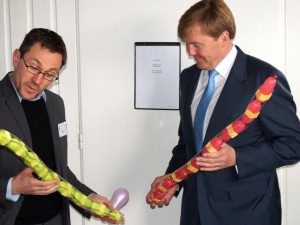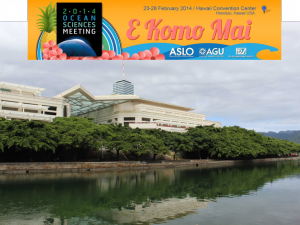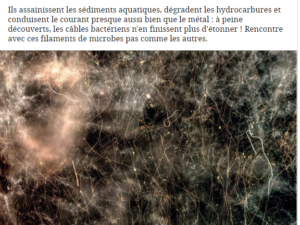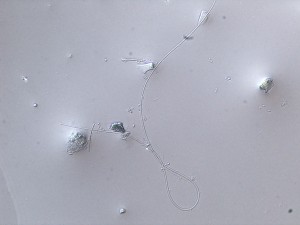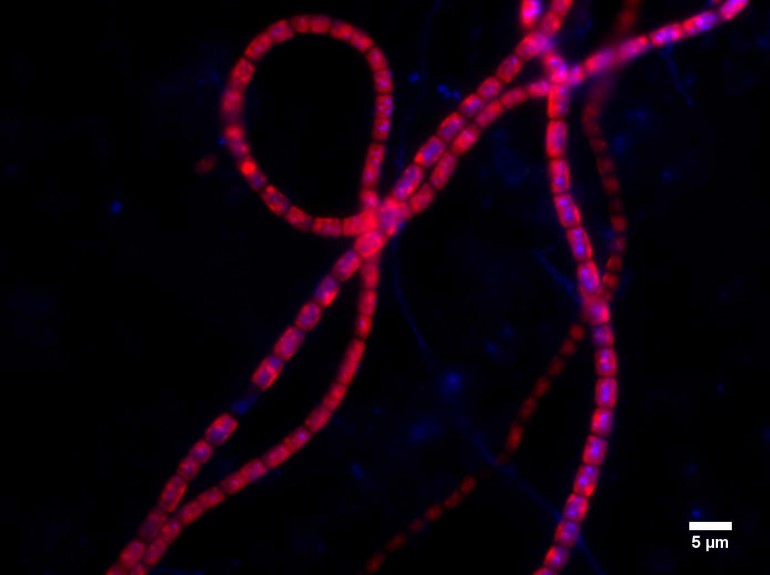
In 1858, the first electrical signals were sent through a telegraph cable across the Atlantic Ocean. As a result, the latest gossip from London travelled to New York in less than ten minutes, where it previously took ten days to deliver a message by ship. Our new study reveals that cable bacteria are essentially doing the same type of long-distance electrical signaling in the seafloor. This reveals a whole new form of electrical communication by micro-organisms, which could potentially lead to novel bio-electrical applications.
A world-record in microbial communication
It has been known for a long time that bacteria have evolved efficient ways to communicate by sensing chemical signals generated by their neighbors. However, such signaling only works in the immediate neighborhood of the bacteria, as chemical signals travel by diffusion, which is a slow and inefficient mechanism to communicate over long distances. Now, a new study demonstrates that bacteria in natural environments are capable of communicating over much longer distances, sending signals in less than 10 minutes over centimeters. “We already knew that long-winding cable bacteria were living in the seafloor of the North sea, which are capable of establishing an electrical current across centimeter distances” explains team leader Prof. dr. ir. Filip Meysman. “The really exciting discovery is that these cable bacteria are capable of adapting their electrical current generation, which enables signal transmission in the seafloor. This way the electricity-generating cable bacteria are essentially functioning as telephone cables.”
Going underground
The new form of electrical signal transmission was discovered by examining marine sediments from a saltmarsh in the south of the Netherlands. “In essence, we took some ordinary black mud back home to the lab, and exposed these sediments to a classical day and night cycle, 12 hours of light followed by 12 hours of darkness” explains Dr. Sairah Malkin, lead author of the study. “But what we subsequently found was really amazing. When we examined the chemistry of the deep sediment layers, we witnessed chemical signals dancing up and dawn, closely tracking the rhythm of the day and night cycle. This was really startling as light goes extinct in the first millimeter, but the response we observed took place much deeper, at 20 mm depth. It’s like being locked up in a dark cave deep underground, but you’re still able to accurately sense that it’s either day or night.”
When examining what was going on, the researchers discovered an intriguing interaction between different microbial communities. On top of the sediment, photosynthetic micro-algae were active, which produce lots of oxygen during light. So the oxygen at the sediment surface skyrocketed during day and plunged during the night. Buried below this algal mat, we found a high density of very fine and long-winding bacterial filaments, which deeply penetrated into the sediment. These so-called ‘cable bacteria’ have been recently discovered and are known to generate electricity. Here we found that the cable bacteria were doing the actual signal transmission. The cable bacteria turn the fluctuating oxygen signal into an electrical current, which is transmitted to deeper sediment layers, where the electrical signal then results into a fluctuating concentration of sulfide. Most sediment organisms are highly sensitive to sulfide, which is a toxic compound, and so, they are capable of detecting the signal. The observed signal transmission also occurred incredibly fast. “When I turned on the light switch, I was amazed at how quickly I could see the response deep in the sediment” remembers Malkin.
Bacterial electricity and bio-electrical applications
In 1858, the first electrical signals were sent through a telegraph cable across the Atlantic Ocean. As a result, the latest gossip from London travelled to New York in less than ten minutes, where it previously took ten days to deliver a message by ship.
The newly discovered microbial interaction works in a very similar way: the algae at the sediment surface produce the oxygen signal (the Londoners), the cable bacteria convert and transmit the signal over long distances (the telegraph system), and the biology in the deep sediment rapidly knows about the latest developments at the surface (the New Yorkers). “This mechanism, whereby bacteria are conveying electrical signals over centimeter-scale distances, completely changes the way we think of how microbial communities interact and communicate” adds team leader Meysman. “Moreover, if the mechanism could be harnessed in an engineered way, this could lead to promising future technological developments. Now we have a microbe from the seafloor that somehow has evolved the enzymatic machinery to perform electrical signaling. If we can find out how our electrogenic bacteria are achieving this, this clearly offers great opportunities for further research into novel bio-electrical materials and technology” emphasizes Meysman. Maybe within some years, solar panels or smartphones will harbor minuscule conducting wires of bacterial origin.
This study features as the Spotlight Article in the current issue of the scientific journal Applied and Environmental Microbiology (#1 cited journal in Microbiology):
Malkin SY, Meysman FJR. 2015. Rapid redox signal transmission by cable bacteria beneath a photosynthetic biofilm. Appl Environ Microbiol 81:948-956. doi:10.1128/AEM.02682-14.

